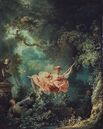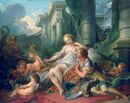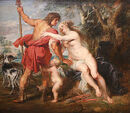Rococo, often called late Baroque, was an architectural and artistic style developed in France in the first half of the eighteenth century. The king of France, Louis XV is often thought to be a key patron and supporter of the movement-- a very likely hypothesis considering the monarch's need to differentiate himself from the king who proceeded him: Louis XIV (a key patron of the Baroque style).
The Rococo Period is known for its lighter and more airy tone, contrasting the heavy dark tone of the preceding Baroque era. It is characterized by its use of pastels and asymmetry, along with the repetitive use of symbols such as shell motifs, and an idealized version of nature. Rococo styling brought about a new wave of romanticism; the new idea of finding a soulmate, someone whom you love, as opposed to the arranged marriages common in the past.
Rococo features exuberant decoration, with an abundance of curves, counter-curves, undulations and elements modeled on nature. The style was highly theatrical, designed to impress and awe at first sight. Floor plans of churches were often complex, featuring interlocking ovals; In palaces, grand stairways became centrepieces, and offered different points of view of the decoration.
The exteriors of Rococo buildings are often simple, while the interiors are entirely dominated by their ornament.The main ornaments of Rococo are: asymmetrical shells, acanthus and other leaves, birds, bouquets of flowers, fruits, musical instruments, angels and Far Eastern elements
In many ways Rococo is an extension of the Baroque. Rococo takes all of the tropes and trends of Baroque art and exaggerates them until there is nothing but ornamentation and artifice left.








